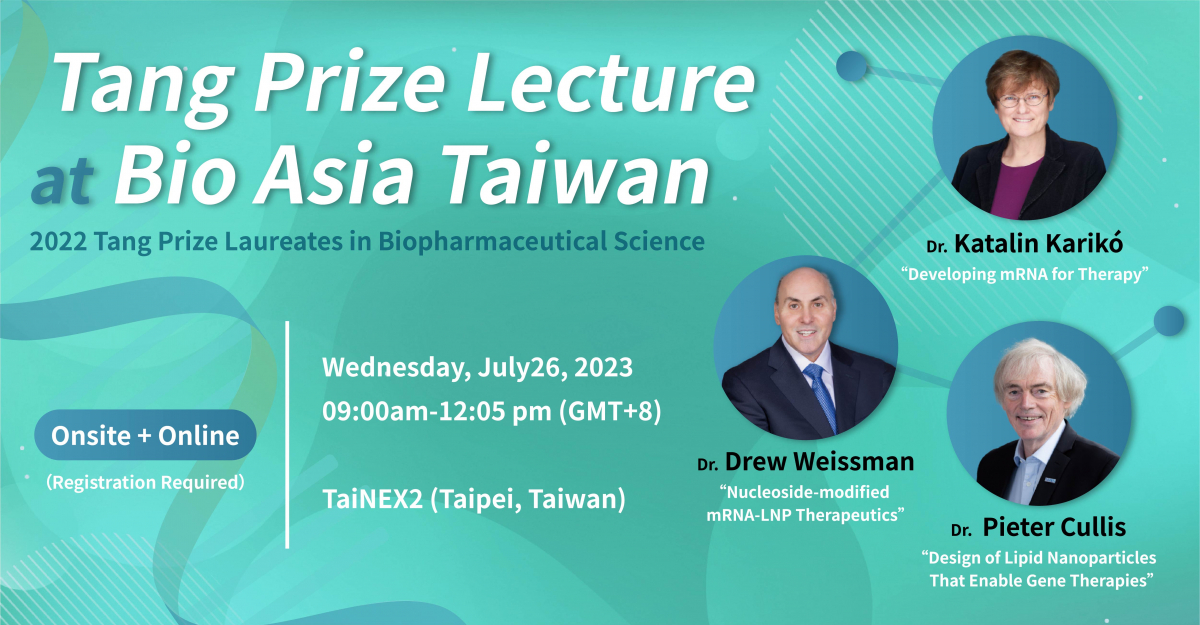|
Event Website |
https://bioasiataiwan.com/ |
|
Event Name |
BIO Asia-Taiwan 2023 |
|
Event Dates |
July 26-30, 2023 |
|
|
Tang Prize Lecture at BIO Asia-Taiwan 2023 |
|
Time |
July 26, 2023 |
|
Venue |
Online |
|
Speakers |
2022 Tang Prize laureate in Biopharmaceutical Science Pieter Cullis (09:45-10:00_livestreamed) Katalin Karikó (10:00-10:15_livestreamed) Drew Weissman (10:55-11:10_pre-recorded) |
|
Abstract 1
Pieter Cullis
|
Design of Lipid Nanoparticles That Enable Gene Therapies Gene therapies employing genetic drugs such as small interfering RNA (siRNA) for gene silencing and messenger RNA (mRNA) for gene expression have the potential to cure most diseases. However, sophisticated delivery systems are required to enable the therapeutic use of nucleic acid polymers as they are quickly broken down in biological fluids, do not accumulate at sites of disease and cannot penetrate into target cells even if they arrive at target tissues. Lipid nanoparticle (LNP) technology is increasingly enabling the clinical potential of genetic drugs by packaging the nucleic acid in well-defined nanoparticles that protect the payload following systemic in vivo administration and facilitate intracellular delivery following uptake into target cells by endocytosis. The first clinical validation of this approach was achieved by the approval of Onpattro by the US FDA in 2018 to treat the disease transthyretin-induced amyloidosis (hATTR.) Onpattro consists of LNPs containing siRNA that silences production of transthyretin in the liver (in hepatocytes) following intravenous administration. In this talk I will describe the historical development of LNP systems leading to the development of Onpattro and how related LNP delivery technology is being employed to enable many mRNA-based gene therapy drugs. A notable example of the success of this approach is the development of Comirnaty, the Pfizer/BioNTech COVID-19 mRNA vaccine, which has played a leading role in alleviating the Covid-19 pandemic. |
|
Abstract 2
Katalin Karikó
|
Developing mRNA for Therapy Messenger RNA was discovered in 1961 and it took 60 years until the first mRNA became FDA-approved product in the form of COVID-19 mRNA vaccine developed by BioNTech/Pfizer and Moderna. During those years a lot of progress has been made by hundreds of scientists. For the first two decades, scientists analyzed mRNA isolated from cells and viruses. It was 1978 when the first-time isolated mRNA encapsulated into liposome was delivered into mammalian cells and the encoded protein was produced. In vitro transcription introduced in 1984 made it possible to generate any desired mRNA from the encoding plasmid using phage RNA polymerases. In the early 90s mRNA was used in animal studies for therapy as well as vaccine against infectious diseases and cancer. Inflammatory nature of the mRNAs limited their in vivo use. Replacing uridine with a naturally occurring alternative, pseudouridine made the mRNA non-immunogenic, more stable and highly translatable. Delivery of the lipid nanoparticle-formulated nucleoside-modified mRNA encoding viral antigens became a platform for effective vaccine. Labile nature of the mRNA is ideal for transient production of the viral antigen, to generate effective antibody and cellular immune response. These discoveries eventually led to the development of the mRNA vaccine that has now helped to fight the pandemic and opened the door for developing breakthrough therapeutics for unmet medical needs. Today, more than 150 clinical trials are running using in vitro-transcribed mRNA for cure. The mRNA platform is revolutionizing the delivery of effective and safe vaccines, therapeutics and gene therapies. |
|
Abstract 3
Drew Weissman |
Nucleoside-modified mRNA-LNP Therapeutics Vaccines prevent 4-5 million deaths a year making them the principal tool of medical intervention worldwide. Nucleoside-modified mRNA was developed over 15 years ago and has become the darling of the COVID-19 pandemic with the first 2 FDA approved vaccines based on it. These vaccines show greater than 90% efficacy and outstanding safety in clinical use. The mechanism for the outstanding immune response induction are the prolonged production of antigen leading to continuous loading of germinal centers and the adjuvant effect of the LNPs, which selectively stimulate T follicular helper cells that drive germinal center responses. Vaccine against many pathogens, including HIV, HCV, HSV2, CMV, universal influenza, coronavirus variants, pancoronavirus, nipah, norovirus, malaria, TB, and many others are currently in development. Nucleoside-modified mRNA is also being developed for therapeutic protein delivery. Clinical trials with mRNA encoded monoclonal antibodies are underway and many other therapeutic or genetic deficient proteins are being developed. Finally, nucleoside-modified mRNA-LNPs are being developed and used for gene therapy. Cas9 knockout to treat transthyretin amyloidosis has shown success in phase 1 trials. We have developed the ability to target specific cells and organs, including lung, brain, heart, CD4+ cells, all T cells, and bone marrow stem cells, with LNPs allowing specific delivery of gene editing and insertion systems to treat diseases such as sickle cell anemia, Nucleoside-modified mRNA will have an enormous potential in the development of new medical therapies.
|
